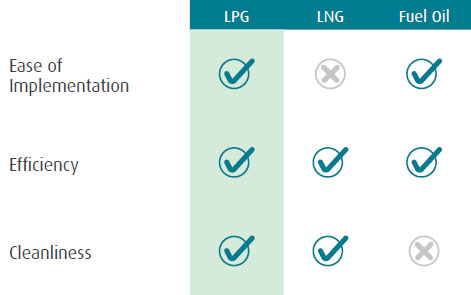POWER OF LPG
Economic growth and the increase in global population are key drivers of the growing demand for energy, and visible effects from increasing levels of carbon (CO2) emissions have accelerated the need for cleaner energy. The boom in shale gas extraction has increased the supply of Liquified Petroleum Gas (LPG) which is used in a range of applications in business, industry, transportation, farming, power generation, cooking and heating.
The world's population is expected to increase by approximately 2 billion people in the next 30 years, while energy consumption is estimated to increase by about 50% between 2018 and 20501. Referred to as one of the world's most versatile forms of energy, LPG consumption is growing across all sectors as it is increasingly recognised as a cleaner form of energy that can meet the demands of a growing global population with less impact to the environment than many alternatives.
IN HOMES
Several billion people around the world use LPG for a wide range of applications. It provides all the benefits of gas supplied to a building through pipes, without a connection to the grid. LPG provides heating as well as the added benefit of instant, completely controllable gas cooking.
LPG emits about 20% less CO2 than heating oil and 50% less than coal
ON THE FARM
LPG is used to increase the production and quality of farm products and provides clean off-grid power for a range of applications such as crop drying, weed and pest control, irrigation and non-highway agricultural vehicles.
For applications such as forklift trucks, LPG offers a
performance unmatched by any alternative fuel
ON THE MOVE
LPG is the preferred alternative automotive transportation fuel. Autogas is the most accepted alternative fuel in the automotive sector with more than 27 million vehicles operating worldwide, compared to less than 4 million electrical vehicles.
98% fewer particles than diesel
CHEMICAL FEEDSTOCK
In chemical production, LPG can be turned into ethylene, propylene and butylene (amongst others) in order to produce synthetic materials as well as production of pharmaceuticals.
The industry takes in about 40% of total LPG supplies
1 United Nations and US Energy Information Administration
AN INNOVATIVE ALTERNATIVE TO MARINE FUEL
With the implementation of the International Maritime Organization’s (IMO) regulation to limit the sulphur content of marine fuels at 0.5%, LPG is considered a viable alternative for marine fuel. Compared with heavy fuel oil (HFO), LPG emits up to 97% less sulphur (SOx), 20% less nitrogen oxides (NOx), 90% less particulate matter (PM) and 25% less carbon emissions. With the continued supply of shale gas resources and established infrastructure in place, BW LPG’s conversion to LPG propelled dual-fuel engines represents a lifecycle upgrade and long-term commitment.

